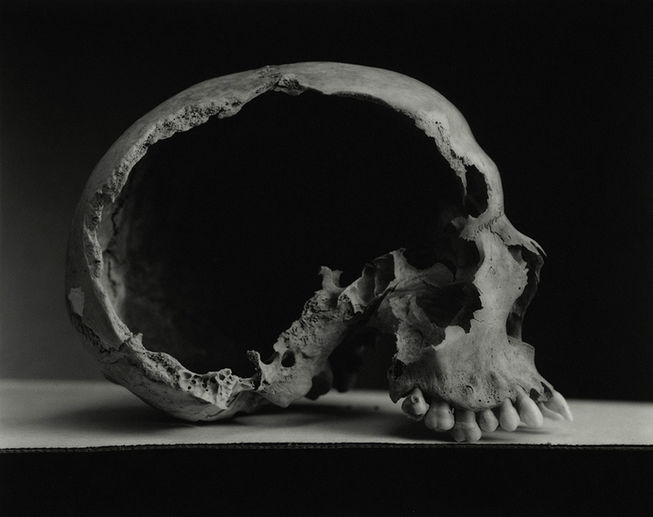Looking at the work of Andrea Modica, professor of photography at Drexel University and recent recipient of the 2015 Knight Purchase Award for Photographic Media, is a bit like reading a poem for the first time in translation. Engaging with her images, I am struck by the knowledge that I carry my own culture alongside my language, and that my language brings me to my experience of Modica’s photography.
This is to say that what results is a harmonious coexistence of estrangement and intimacy with the image. It’s widely understood that you can never really read the same poem in translation. Many believe visual art (and specifically photography) is different from language, that it is somehow less culturally contingent, or even a container for a sort of singular, “universal” meaning.
But Modica’s work is particularly poetic in that it boldly questions such oversimplifications, drawing attention to the language systems that inform our diverse understandings of images. In one black-and-white photograph, a distinctive silhouette emerges from behind a long, pale curtain, both defined and obscured by its paper or canvas-like veiling. To the viewer, the semiotics of this shadow, with its distinct black and white contours, constitutes a horse.
Modica examines the relationship between representation and meaning in such poignant works, interrogating the process by which we articulate perceived realities. The silhouetted quality of the equine profile in this particular image conjures photography’s daguerreotype origins, asserting the work’s contemporary relevance through reference to a history of artistic representation, including mimesis. Literary translation, too, is charged with mimesis, for better or for worse.
But this history is addressed via a certain discord, a palpable unease, which characterizes the image. The shadow that we classify as a horse exists within an “unnatural” setting: tiled walls suggestive of an indoor swimming pool punctuated with bits of machinery. I’m unsettled by the perceived juxtaposition, and am prompted to ask myself what kind of associations influence this distinct reading. The enigmatic image, it turns out, was composed in a “horse hospital”, and the remainder of the series consists of images of these powerful animals sprawled out, ostensibly post-operatively, within this clinical setting. Such a disruption of expectation is characteristic of Modica’s diverse body of work, which possesses a significant narrative quality and poignantly illustrates fellow photographer Sally Mann’s declaration (in her recently published autobiography Hold Still) that “all perception is selection”.
Modica’s oeuvre consists of images taken in both the United States and in Italy, such as scenes from rural family life, portraits of teenage best friends, and evocative landscapes and still lives, among them compositions featuring human skulls in psychiatric hospitals. This last subject, comprising a series evocatively entitled Human Being, evidences particular sensitivity to art in historical representation, inviting comparison to such precedents as the paintings of Georgia O’Keefe or Paul Cezanne. Modica’s images of human skulls are abstracted through perspective into fissured and immense landscapes, referencing both the proscribed cultural significance of the human head and its potential for distortion through representation.
The comparison to O’Keefe’s artistic legacy is valid, as O’Keefe’s images of organic material (such as skulls) are often defined by their dominant interpretation as yonic symbols. In this sense, Modica’s use of the same iconic subject matter functions to emphasize the role of society in meaning-making and symbiology. A particular Modica image, showing the underside of two human skulls, seems especially relatable: the foramen magnums, or spinal holes, gape like chasms, inviting diverse, O’Keefe-esque associations.
The Human Being series similarly references famous works like Cezanne’s 1901 Pyramid Of Skulls, in which distinct Impressionist brushstrokes draw attention to the surface materiality of a painting, highlighting its existence as a subjective cultural creation.
Modica’s photographs continue in this tradition, critiquing the objectivity that has historically (and falsely!) been attributed to photography. In so doing, she emphasizes photography’s status as high art, while drawing attention to the urgent necessity to question this faux-documentarian impulse. Modica’s oeuvre reminds us that works of art, from literary translations to photographs, contain multitudes.
Modica’s work will be exhibited in Ohio at the Akron Art Museum’s Judith Bear Isroff Gallery from October 10th, 2015 to February 1, 2016. It can also be seen in Italy October 18th– 24th, 2015, in Places and Faces in Tuscany, Project Basho, Bagni di Lucca, as well as in the permanent collections of such institutions as The Museum of Modern Art, The Metropolitan Museum of Art, and the Whitney Museum of American Art.
*****
Image by Andrea Modica, via her website here.
***
Rachel Bonner is an aspiring art historian/independent curator, with a BA in Art History (minor in Literature) from Ursinus College. She lives in the Greater Philadelphia Area and is passionate about conceptual and performance art and its affinities with language/poetry. In her free time, she enjoys traveling, running, and doing hatha yoga.

